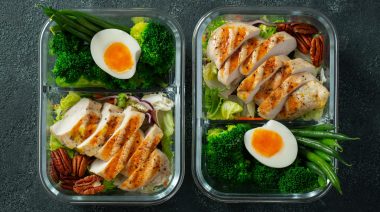I remember the first time I heard about low-carb diets. It was sophomore year and my family was in the book section at Sam’s Club. My parents discussed the new diet they planned to start the following week as they thumbed through Dr. Atkins’ New Diet Revolution.
Panic struck the core of my teenaged being as I listened to the rules for the induction period. No pizza, no pasta, no bread – not even any fruit. (I thought fruit was healthy?) I prayed my parents would not force this absurdity on their innocent children.
A lot has changed since then. Mostly, things are more confusing. There are long lists of low-carb diets that claim to be the best. And then there are the diets that don’t really claim to be low-carb at all, but everyone else insists they are. And don’t even say the word “ketosis” or I’ll go eat a dozen Krispy Kremes right now.
Can’t this be more straightforward?
The Good
So let’s cut to the chase – is low-carb good for athletes or not? As Kalli Youngstrom noted in her article, Do You Even Low Carb? A Beginner’s Guide to Keto, anecdotal evidence suggests a low-carbohydrate, ketogenic diet is both sustainable and beneficial for all kinds of athletes, from ultramarathoners to powerlifters:
In terms of physique and appearance, the proof is in the pudding when it comes to the long history of professional bodybuilders and their use of ketogenic diets to achieve nearly impossible levels of lean body mass and conditioning (see Vince Gironda). But the jury is often split when it comes to functional and athletic strength and performance.
Cultures such as the Inuit who have historically been forced into a ketogenic-style diet reflect the sustainability of both strength and stamina while maintaining ketosis. And both strength and endurance athletes, such as powerlifter Mark Bell and endurance runner Timothy Allen Olson have found success in applying the keto diet to their athletic endeavors.
That anecdotal evidence is supported by studies supporting the use of low-carb diets for optimal athletic performance. For example, coach Joshua Wortman covered a study in Nutrition Journal that investigated the effects of a very-low-carb ketogenic diet (VLCKD) on gymnasts. The researchers found no evidence that the diet negatively impacted performance.
But that’s not to say there were no changes at all. The gymnasts on the VLCKD demonstrated significant decreases in body weight, fat mass, and fat percentage, as well as an increase in lean body mass percentage. Sounds appealing, right?
The Bad
But as is often the case with research, it’s not always that black and white. In his article, Does Technique Suffer on a Low-Carb Diet? coach Doug Dupont reported on another recent study (also with gymnasts, coincidentally) that wasn’t as favorable toward skipping out on carbs:
[R]esearchers examined young female gymnasts during a balance beam workout. Some of them drank a carb drink and some of them didn’t. Some of them were already fatigued before getting on the balance beam and some weren’t. Considering what the researchers believed might happen – that those without carbs would take a header off the beam more often – it seems like a cruel test, but I suppose that makes it easier for study.
Sure enough, the girls who went carbless and were fatigued ahead of time fell off the beam over twice as much as those who were fatigued ahead of time but drank a twenty percent carb solution.
Granted, the gymnasts were already fatigued, but this study still offers interesting information for any athlete whose sport is highly technical. If you’re going into a technical workout already fatiqued, a carbohydrate source could keep you safe.

Low-carb diets have been shown to affect technique in fatigued athletes.
Coach Tom Kelso interviewed low-carb, high-intensity athlete Frederick Hahn to get his perspective on fueling performance on a minimal carb intake. Hahn acknowledged the importance of tailoring your diet to your specific sport, but he also noted there’s no reason to go overboard on your carb intake, regardless of the type of diet you choose:
[S]ome athletic endeavors like MMA, sprinting, short-burst speed skating, and other highly glycolytic sports require quick replenishment of glycogen, so for these athletes a low-carb diet may not be optimal. But just an extra sweet potato or half cup of rice may be all these athletes require. No athlete requires a high carb diet.
Read the rest of the interview in Tom’s article, Interview With Low-Carb, High-Intensity Proponent Frederick Hahn.
Carb Cycling: Another Approach
If low-carb sounds intimidating, consider carb cycling. In his article, Calorie and Carb Cycling: Breaking Through Your Diet Plateau, coach Nate Miyaki detailed how carb cycling can help you lose unwanted fat:
Some coaches recommend more extreme fluctuations in carbs, with an accompanying increase or decrease in dietary fat to compensate. This is what some would consider true carb cycling. Here’s how that looks:
- On rest/lower calories days, eat a low carbohydrate diet with carbs coming primarily from vegetables and whole fruits. No starches. Make up the rest of your calorie requirements with dietary fat (fattier cuts of meat and/or added whole food fats).
- On training/higher calorie days, eat a lower fat, higher carbohydrate diet. Get your dietary fat as by-product of relatively lean protein sources, don’t add fats, and get the rest of your calorie requirements from starchy carbohydrates.
This approach takes your training into account and might be easier to follow, since you’re still allowed to eat a lot of carbs on certain days. Holistic nutritionist Kevin Cann also recommended carb cycling in his article, Ketogenic Diet Considerations: Do We Need Carbs for Performance? Kevin noted, “I personally promote a cyclic low-carbohydrate diet to those people looking to lose weight, with the majority of their carbohydrate intake coming in the meal following a workout.”

Carb cycling is another popular option among athletes.
Give It Time
If you do decide low-carb is right for you, give yourself plenty of time to adjust. Your body may have gotten used to a vicious cycle of sugar cravings, and it takes a while to get that in check. This is especially true if you plan to achieve ketosis, as explained by coach Kalli Youngstrom:
Studies have shown that on average it takes two to three weeks for a body to transition from using carbohydrates as a readily available source of energy to using ketones as fuel, but once an individual becomes “keto adapted” the negative effects go away.
For those who have attempted to go low carb numerous times, but never at a low enough level to reach ketosis or long enough to transition to a ketone-producing state, it is expected the experiences will be mainly negative in terms of feeling and performance. This person has never truly reaped the benefits of a low-carb diet, other than a possible few pounds of water weight loss that may occur in the first few days.
Even if you aren’t planning to reach ketosis, transitioning to low-carb can be surprisingly difficult. Give yourself plenty of time, and consider finding a coach or partner to keep you on track. With support, patience, and dedication, you might find you don’t miss those Krispy Kremes after all.
Have you experimented with low-carb diets? Share your experience in the comments below!
More Like This:
- 2 Sugar- and Dairy-Free Ketogenic Smoothie Recipes
- Why a Ketogenic Approach to Nutrition Is Ideal for Your Health
- Is Paleo Ketogenic and Is That a Good Idea?
- New on Breaking Muscle Today
Photos courtesy of Shutterstock.






